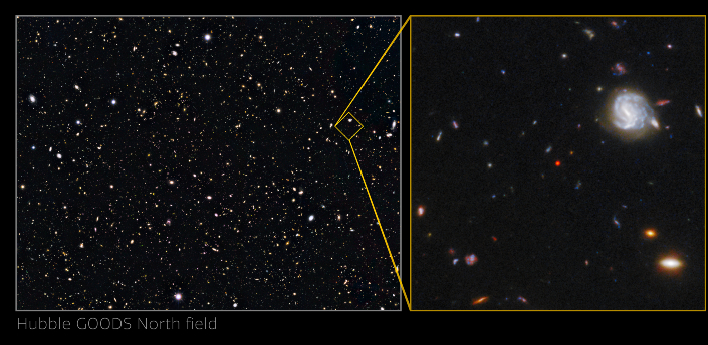Astrophysicists Spot A Supermassive Object From The Cosmic Dawn That's Never Been Seen Before

Until recently, a supermassive black hole, known as GNz7q, has been playing a game of hide and seek with astronomers in one of the best-studied areas of the night sky, the Great Observations Origins Deep Survey-North (GOODS-North) field. The black hole had proven to be a ninja at remaining undetected until a group of researchers scoured the archival data from Hubble's Advanced Camera for Surveys and were able to reveal it.
GNz7q is thought to have existed about 750 million years after the big bang and is a newly formed black hole. The team of researchers found a compact source of ultraviolet (UV) and infrared light detected by Hubble, and say that it could not be caused by emission from galaxies, but is instead consistent with the radiation likely from materials that are plunging onto a black hole. Typically quickly forming black holes in early star-forming galaxies are only predicted by theories and computer simulations and had not been observed until now, according to a NASA blog.
"Our analysis suggests that GNz7q is the first example of a rapidly growing black hole in the dusty core of a starburst galaxy at an epoch close to the earliest supermassive black hole known in the universe," stated Seiji Fujimoto, an astronomer at the Niels Bohr Institute of the University of Copenhagen and lead author for the Nature paper documenting the discovery. "The object's properties across the electromagnetic spectrum are in excellent agreement with predictions from the theoretical simulations."
The recently detected black hole has features of both a dusty starburst galaxy and a luminous quasar, and therefore could be the missing link between the two. GNz7q shows the dust reddened color of quasar light, but lacks other features that are usually observed in very luminous quasars. The team believes that the central black hole in GNz7q is still very young.
"GNz7q provides a direct connection between these two rare populations and provides a new avenue toward understanding the rapid growth of supermassive black holes in the early days of the universe," added Fujimoto. "Our discovery provides an example of precursors to the supermassive black holes we observe at later epochs."
The team understands that other interpretations cannot be completely ruled out, however, they believe the data is in strong agreement with the theoretical predictions. Discovering GNz7q was only possible due to the uniquely detailed, multiwavelength datasets available for GOODS-North. Researchers say they look forward to taking advantage of the James Webb Space Telescope's (JWST) spectroscopic instruments to further study celestial objects such as GNz7q in unparalleled detail.
"Fully characterizing these objects and probing their evolution and underlying physics in much greater detail will become possible with the James Webb Space Telescope," said Fujimoto. "Once in regular operation, Webb will have the power to decisively determine how common these rapidly growing black holes truly are."
Top Image Credit: NASA/ESA N.Bartmann


